The story of Cleveland Clinic’s pandemic surge facility
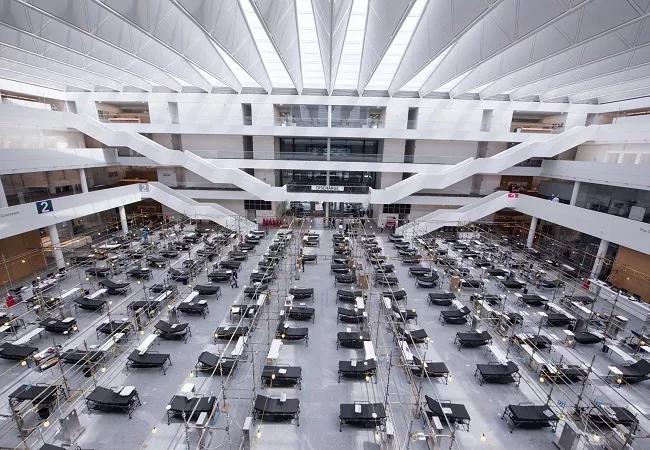
Normally, creating a new hospital is a methodical, years-long process of planning, design and construction.
Cleveland Clinic is a non-profit academic medical center. Advertising on our site helps support our mission. We do not endorse non-Cleveland Clinic products or services. Policy
But the urgency of the COVID-19 pandemic has shredded normal timetables. Cleveland Clinic’s conversion of the Health Education Campus (HEC) main building from a medical education site to a 1,006-bed surge hospital for low-acuity COVID-19 patients was accomplished in less than a month.
The temporary facility, dubbed Hope Hospital to convey comfort and optimism, will be available if needed beginning April 15.
“It’s been a heroic effort by hundreds of people,” says Edmund S. Sabanegh, Jr., MD, Cleveland Clinic’s President of Main Campus and Regional Hospitals. “There’s really no precedent for us doing something this big this quickly. It’s been amazing to watch clinical leaders and operations, construction, design and nursing teams all come together in a very short window of time and literally build a thousand-bed-capability facility that rivals fixed buildings in many parts of the country. Our teams solved problem after problem that might have been considered insurmountable.”
Facing the enormous logistical challenges of getting the surge hospital up and running, “everyone has said yes. No one has said no,” says Cleveland Clinic Chief of Operations William M. Peacock, III. “And if a problem comes up, they say, ‘Let’s find a way.’”












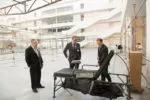
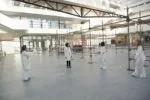



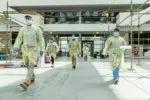

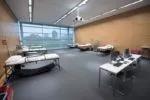

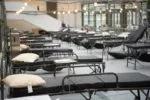


Slide 1/24
The decision to create the surge hospital was based on computer modeling by Cleveland Clinic and other entities of the number of anticipated COVID-19 cases in Northeast Ohio, and on consultation with local, state and federal officials about how to respond.
The modeling was highly variable. But it indicated that in the worst-case scenario, with no social-distancing efforts, Cleveland Clinic health system’s pre-pandemic capacity in its main campus and regional hospitals — 2,800 general medical beds and 550 intensive care unit (ICU) beds — would be inadequate to handle the expected crush of COVID-19 cases as the viral infection peaked in the state in late April or early May.
“We were looking at needing to grow our capacity by almost three times,” Dr. Sabanegh says.
Some of that shortfall could be remedied by expanding treatment capabilities in existing Cleveland Clinic hospitals, by retrieving unused beds from storage and procuring new ones. But it became clear that a dedicated large-scale facility also would be needed to accommodate the anticipated COVID-19 caseload.
Ohio Gov. Mike DeWine’s stay-at-home order, school closures and other actions taken by the state government “have been instrumental, hopefully, in heading off the worst-case scenario,” Dr. Sabanegh says. “But for us to ramp up, we had to presume the worst. When the patients come, they come very quickly, in large numbers that require advanced capabilities that no hospital system is ready for unless they’ve been planning. We wanted to get ahead of this.”
Ohio is planning for a total of six COVID-19 surge hospitals in its largest population hubs. Five are in retrofitted convention centers. Cleveland Clinic considered that approach but opted instead to convert the recently constructed HEC’s four-story, 477,000-square-foot Sheila and Eric Samson Pavilion, which is across the street from main campus hospital buildings. Cleveland’s two convention centers are several miles away.
The HEC’s nearness to the main hospital’s acute care facilities and other resources made it the clear choice. “It keeps our caregivers and the logistics needed to support them proximate to the main campus and its logistics systems,” Mr. Peacock says.
“We could leverage our whole workforce to assist with bringing the surge hospital online,” adds Dr. Sabanegh. “If necessary, we could transfer patients to the main campus ICUs very easily.”
The HEC is a joint venture between Cleveland Clinic and Case Western Reserve University (CWRU). Designed by Lord Norman Foster, one of the world’s foremost contemporary architects, and opened in 2019, the HEC’s Samson Pavilion houses Cleveland Clinic’s Lerner College of Medicine and the CWRU schools of Medicine, Dental Medicine, and the Frances Payne Bolton School of Nursing.
In-person classes were cancelled and the pavilion was shuttered in mid-March as Ohio’s pandemic social distancing restrictions went into effect, making the building available for repurposing. CWRU officials readily agreed and the two institutions informed the HEC’s faculty and staff in late March of the transition plan. “I feel deep gratitude that the HEC will allow more patients to receive essential care during this crisis,” CWRU President Barbara Snyder says.
The three-acre structure’s vast, 80-foot-tall central atrium and open-plan classrooms, lecture halls, labs and offices — meant to promote collaboration among the health professionals who train there — provided ample raw space for the surge facility. But a formidable amount of work had to be done to ready it for patients.
To start, furnishings, non-essential equipment, personal belongings and even the 20 large Ficus Nitida trees that decorated the atrium were carefully packed, moved out and stored. Simultaneously, clinical and operations teams began planning how to equip and utilize space on all four floors for medical care. They determined that the reconfigured building could accommodate 1,006 patients — capacity equivalent to the U.S. Navy hospital ship Comfort currently providing pandemic assistance in New York City.
Hope Hospital is meant to treat low-acuity Covid-19 cases, freeing up ICUs to care for sicker individuals. Its patients must be ambulatory and need no more than 3 liters of oxygen per minute. Supplying that oxygen, as well as all of the other necessary patient and caregiver resources, to a building that wasn’t designed to be a hospital, was daunting, says Hope Hospital Chief Operating Officer Robert Stall.
Working around the clock, tradespeople in teams of 100 per shift installed partitions, patient beds, additional lighting, medical monitoring equipment, computers, exterior oxygen tanks and 6 miles of medical-grade copper tubing to relay airflow to individual headboards. All microwave sources were removed from the building to reduce fire risk. Electrical outlets were converted to “red plugs,” indicating they could supply uninterrupted power from emergency generators if needed. A temporary ambulance bay was set up to receive patients coming from main campus or other area hospitals.
“We had to install a different WiFi system so that we would stay connected for virtual patient monitoring and to access our electronic medical record throughout the facility,” Dr. Sabanegh says. “We had to deploy nurse call systems so that a patient could request assistance. We had to develop additional bathroom systems.”
Securing the hospital beds and other medical equipment and supplies at a time of high national demand was challenging.
“We stressed all aspects of the supply chain system to make it happen,” Mr. Peacock says. “There were plenty of middle-of-the-night orders,” Dr. Sabanegh adds.
While the federal government’s stimulus package has provisions to help healthcare providers offset some of the expenses of their pandemic response, Cleveland Clinic currently is bearing the surge hospital’s multimillion-dollar cost. Cleveland Clinic CEO and President Tom Mihaljevic, MD, “has been a fantastic leader,” Dr. Sabanegh says. “From the very start, he said, ‘Do what’s right for this community.’ And that’s what this group did.”
Approximately 800 caregivers will staff Hope Hospital, including 40 physicians, additional residents and fellows, more than 350 nurses, and more than 300 support personnel.
Under the direction of Hope Hospital Chief Medical Officer Rita Pappas, MD, and Chief Nursing Officer Shannon Pengel, MSN, RN, multidisciplinary teams developed clinical workflows, safety procedures and other guidelines so that caregivers could function seamlessly in an unfamiliar space. Team members met in the building’s whiteboard-equipped classrooms to map out the directives, then walked the soon-to-be treatment areas to verify that their plans would work in real-world settings. They developed “playbooks” for all surge hospital personnel, describing everything from where and how to don personal protective equipment to the location of break areas. To aid navigation, the building was divided into color-coded units, just like a traditional hospital.
“A major lesson I learned early on is leaning on other healthcare providers” for advice and guidance, Dr. Pappas says. “Bringing people together and talking about every possibility has been a huge key to our success,” agrees Ms. Pengel.
The planning effort extends to how the surge hospital will be decommissioned and returned to its original state — including deep cleaning, removal of the medical infrastructure and reinstallation of its fixtures and furnishings — once the pandemic emergency subsides.
“We have an exit strategy and we feel the hospital can be taken down pretty quickly,” Dr. Sabanegh says. “We’ll turn it back over the same way we found it.”
When that will happen is uncertain, as is the level of demand for the surge hospital’s services. Its planners hope utilization will be well below 100 %, which would indicate that social distancing and other efforts to mitigate the pandemic are working.
“We will only start admitting patients to this facility when conventional bed space in our hospitals is nearly full,” Dr. Sabanegh says. “This facility will stay open as long as we need it. My hope is we don’t end up having to use it to a high degree, but if we do, we’re going to take great care of our patients. And if we don’t need it, it establishes a capability for us in the future, for other emergencies that could be awaiting our region.”
In the dark days of World War I, a group of Cleveland doctors, nurses and support staff led by surgeon George W. Crile, MD, became the first American unit to arrive in France, establishing a field hospital to treat the horrific casualties of trench warfare and rampant disease.
Military efficiency and collaboration were the only means to handle the daily crises and onslaught of patients. In long conversations, Dr. Crile and his partners Frank Bunts, MD, and William Lower, MD, hatched the idea of recreating this model of teamwork back home — the genesis of Cleveland Clinic’s group practice, which they and John Phillips, MD, founded in 1921.
Nearly a century later, in the midst of another global conflagration, the creation of Hope Hospital echoes the spirit of Cleveland Clinic’s forefathers.
“This gets back to our fundamentals,” Dr. Sabanegh says, “which is to identify a need and be innovative in how you address it. To use the basic principles of what’s right in medical care and solve a problem.”
Says Mr. Peacock: “What we’re doing inside the Health Education Campus … well, somewhere up above, I can imagine those four founders are smiling.”

Patients report improved sense of smell and taste

Clinicians who are accustomed to uncertainty can do well by patients

Unique skin changes can occur after infection or vaccine

Cleveland Clinic analysis suggests that obtaining care for the virus might reveal a previously undiagnosed condition

As the pandemic evolves, rheumatologists must continue to be mindful of most vulnerable patients

Early results suggest positive outcomes from COVID-19 PrEP treatment

Could the virus have caused the condition or triggered previously undiagnosed disease?

Five categories of cutaneous abnormalities are associated with COVID-19